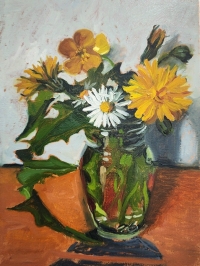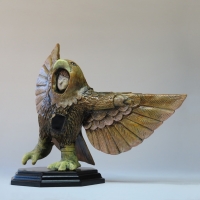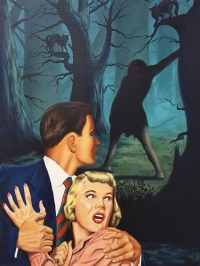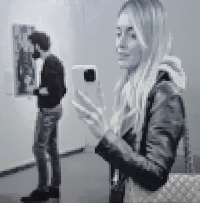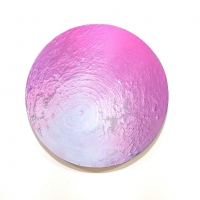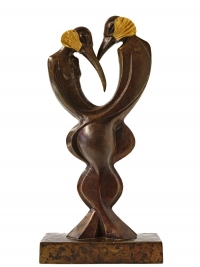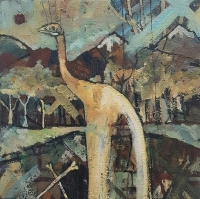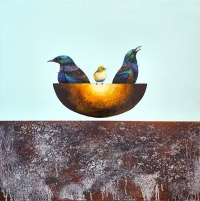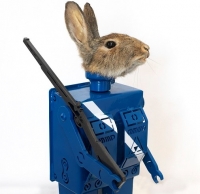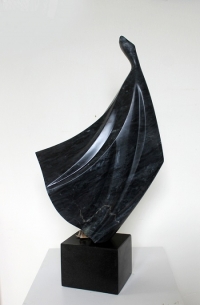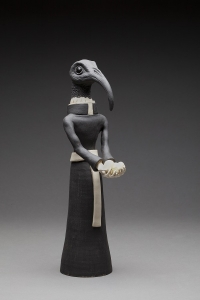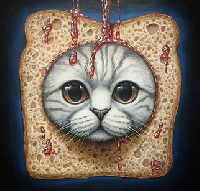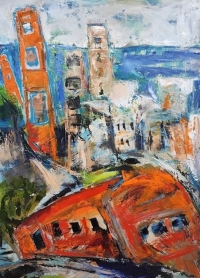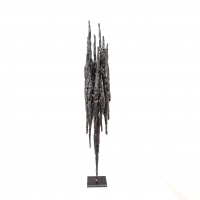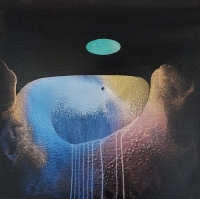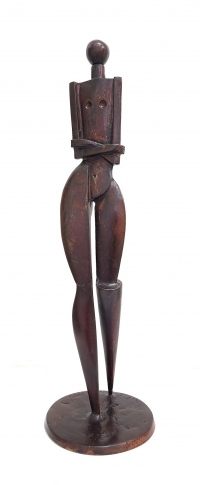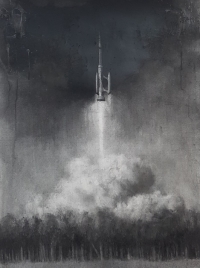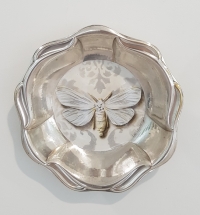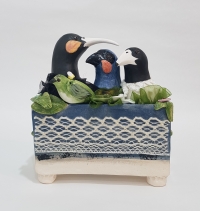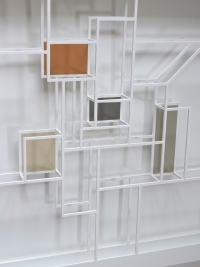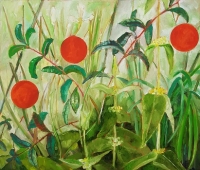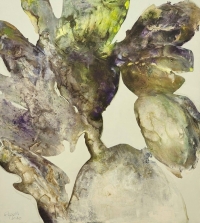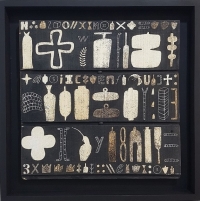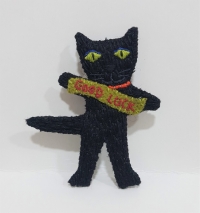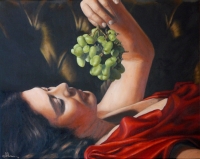Artists
Jennifer Baker
The oil paintings of Jennifer Baker celebrate the transient beauty of flowers, and the simple beauty of everyday objects.
“I’ve been making art since I was a child."
"I started painting flowers a few years ago. More recently, the flowers in my paintings are foraged, either from my own garden, a neighbour's, my mum’s, along the side of the road, in a ditch, or some other random spot."
"Foraging and making my own arrangements has become a really important part of my artistic process."
"Apart from it being a good connector with neighbours (I enjoy knocking on the door and having a good chat), it forces me to work with what I’ve got, and it allows me to see and appreciate things that I might not have noticed otherwise.”
Working from her home studio in Palmerston North, in 2024 Jennifer won First Prize in Palmerston North’s Studio on the Square Painting Competition, following on from her receipt of a merit prize in 2021.
In 2025 Jennifer received a Judges’ mention of excellence in the Manawatu Art Awards hosted by Feilding and District Art Society.
RECENT FEATURE EXHIBITIONS
Justin Cook
Palmerston North sculptor Justin Cook creates small - often whimsical - works in clay, glass, and metal.
"My practice is driven by experimentation, where ideas shape the form and surface decoration."
"Nostalgia, play, power, and change are key themes of my sculptures, often explored through animals as metaphors for human experiences."
"Surface decoration is an important part of my process. For my ceramic pieces, I use a combination of commercial and home-made glazes and trial these at a range of temperatures to create varied textures. Cast glass works are coldworked by hand."
"My background and interest in science has had a big influence on the techniques I use and the subject of my work. The aim is to spark curiosity and present multiple meanings, inviting the viewer to pause, think, and consider different perspectives."
Matthew Steedman
Born in Christchurch in 1976, Matthew Steedman holds a Bachelor of Fine Arts degree from Quay School of the Arts, Whanganui (1999).
Now based in Palmerston North, the artist is best known for his pixelated oil paintings.
The artist's first solo exhibition at ZIMMERMAN was "Grey Matter" in November 2023 - an exhibition of eight large greyscale pixelated paintings.
FEATURE EXHIBITION
Deano Shirriffs
Deano Shirriffs was born in 1982 in Palmerston North, with the sun sign Aries Sun and the moon sign Aquarius Moon.
Shirriffs' abstract landscape paintings explore a connection to the natural world and the cosmos.
Finding form and inspiration from the environment, and the alignments of planets and stars, the artist embeds in his paintings concepts relevant to the themes he investigates in each new body of work.
After achieving an A Bursary with a scholarship in photography at Palmerston North Boys’ High School, Shirriffs’ ongoing art studies included terms at both Elam School of Fine Arts (Auckland) and the School of Fine Arts at Massey University (Wellington campus).
Shirriffs graduated with a Bachelor Fine Arts (Dunedin) in 2012, having also been awarded top of the painting department in his year.
FEATURE EXHIBITION
Dan Dibble
Born in 1983 in Palmerston North, Dan Dibble is the son of accomplished local artists Fran and Paul Dibble.
Dan started working with bronze from the age of eight, when the Dibble foundry was located in the family's backyard. Over the years, Dan continued to assist at the foundry, and in 2022 mounted his first exhibition of bronze sculptures at Zimmerman Art Gallery.
Dan's sculptural explorations challenge the possibilities of bronze casting. Describing his work as a journey of discovery, Dan is keen to build on the experience garnered in the Dibble foundry to pioneer his own processes for working in bronze.
FEATURE EXHIBITIONS
Dibbles & Son - September 2022
Selected Sculptures - October 2024
Brett a'Court
Born in Christchurch in 1968, Brett a'Court is a full time artist.
Brett became interested in art at a very young age, finding meaning through painting early in life.
His relationship with art quickly developed into a lifelong passion to seek truth and understanding, and to make a spiritual connection through his faith between the physical and metaphysical realms.
Brett was a finalist in the NZ Paint and Printmaking Awards for 2023, 2025 and 2026, and in 2023 was a finalist in the Molly Morpeth Canaday Award.
Brett's work is found in both private and public art collections throughout New Zealand. The artist lives and works in Waipu, a small Northland town he moved to with his wife more than 25 years ago.
Ian Chapman
Born in 1967 in Brighton, England, Ian Chapman trained in Visual Art at the Polytechnic in Masterton.
The artist has been involved with King Street Artworks in Masterton since its inception in 1997, first as a tutor and now as Manager.
Chapman has exhibited across New Zealand, from the Artist Room in Dunedin, to the Pah Homestead in Auckland, where Chapman was a finalist in the prestigious Wallace Art Awards (1994).
In 2019, Chapman’s solo exhibition “A Song for the Uncoordinated” was exhibited at Aratoi Museum of Art and History, and later that year the artist went on to receive the premier award at the Wairarapa Art Review.
Chapman describes himself as “desperately normal on the outside and a little irregular on the inside.” With influences including 50’s sci fi, steampunk, retro toys and the cartoons of Gary Larson, the artist’s surreal works feature “a mix of unlikely things in an unlikely landscape.”
In Chapman’s art works “the title is everything. It may come during the painting or months afterwards. But it will come, and only then will I consider the painting finished.”
FEATURE EXHIBITIONS
Creature Comforts - October 2025
A Midsummer Night's Dream - August 2024
Sean Crawford
Sean Crawford graduated with a Bachelor of Design in 2003, and has been a full-time sculptor ever since.
Growing up in Wellington, and holidaying in the Wairarapa, Crawford spent his summer holidays helping out on local farms with livestock and pest control. His sculptural work continues to be influenced and inspired by the Wairarapa bush and the contradictions of New Zealand's colonial past.
Crawford uses a variety of materials, ranging from laser-cut steel to taxidermy.
In 2019 and 2020 sculptures by Crawford made the finals of the prestigious Wallace Art Awards, the longest surviving annual art awards of their kind in New Zealand.
In 2020 Crawford's public artwork, The Head of John Doe, was installed in Palmerston North. The Corten steel sculpture comprises a doe, fabricated from male huia icons, gazing upward toward the trophy head of a buck, fabricated from female huia icons. There is a direct line of sight from the raised head of the doe to the eyes of the mounted buck, suggesting an almost Romeo and Juliet relationship between the pair.
Crawford includes among his career highlights the 2015 commissioned sculpture ‘Waiting for Hammond’: a two metre tall huia bird set on a headland overlooking the Irish Sea. It’s a sign that his ideas, although largely home-grown, are just as relevant on the world stage.
Anna Korver
Anna Korver holds a Bachelor of Fine Arts in sculpture from the University of Canterbury (2003).
A full time sculptor, Korver has participated in more than 80 national and international sculpture symposia and sculpture park exhibitions.
In New Zealand, Korver’s work has been exhibited on multiple occasions at New Zealand Sculpture Onshore (Devonport), Sculpture on the Peninsula (Banks Peninsula) and Art in a Garden (Canterbury). Korver has twice exhibited as part of Shapeshifter at the Dowse (Lower Hutt), and has twice been a finalist in the prestigious Wallace Art Awards (2016 and 2018).
The artist was awarded first prize for her work at sculpture symposia in Rotorua (2014), Whangarei (2012) and Coromandel (2008).
In 2021, following a three-week live sculpting period, Korver was awarded first prize at the Tuwaiq International Sculpture Symposium in Saudi Arabia.
Korver is a former a co-owner of The Korver Molloy Gallery and Sculpture Park, which operated in Taranaki for four years.
FEATURE EXHIBITIONS
Stairways and Enclaves - December 2018 / January 2019
Angela Tier
Born in 1980, Whanganui artist Angela Tier holds a Bachelor of Fine Arts with distinction.
Angela’s sculptural works are hand built using the coiling technique, in which coils of clay are gradually stacked and joined one on top of the other. “I like working in the coils as it's a very old technique.”
In recent years Angela has created a series of bird urns, representing some of the New Zealand’s extinct and endangered birds. “It only takes a few centuries of human activity to have such an impact on the environment that we might lose them forever.”
In 2019 Angela turned her attention to our endangered native bats, pekapeka, and sculpted 100 small bat urns. Measuring between 10 and 16 cm high, each bat is unique. Some are styled after existing bat species, while others are imaginery, representing species not yet discovered.
In 2021, Angela released a series of "Genie Birds" - a reflection on the environmental impact of introduced birds. Yet while "the genie is out of the bottle" and exotic species have forever changed New Zealand, Angela's sculptures impart a sense of the artist's appreciation for the natural beauty and character of these relative newcomers to our shores.
Another recent series is the "Liberator Dog" works, inspired in part by Egyptian Shabti (mummy-like figurines) and Guatemalan worry dolls. If you write your anxieties down on paper, and post the paper into the opening at the back of the Liberator Dog, then the "black dog" will take your unwanted thoughts - a transference of the worries from your innner mind away from yourself.
Angela has exhibited in numerous group shows as well as award-based exhibitions. ZIMMERMAN has represented Angela since 2018.
FEATURE EXHIBITIONS
Bittersweet Dreams: Flight of the Genie Birds - November 2021
Paige Williams
Born in 1997, Paige Williams is a surreal animal painter fascinated by “the weird and interesting.”
After commencing studies toward a career in gaming, in 2016 Paige withdrew from University to pursue a professional career in painting and illustration.
Working from a home studio in Auckland, Paige paints “all sorts of animals in strange or unusual situations.”
Paige exhibited works at the 2016 Royal Easter Show in Auckland, and was subsequently profiled in the Youth Page of The New Zealand Artist Magazine (May/June 2016).
Paige’s first solo exhibition was held at ZIMMERMAN in October 2016, followed by further successful solo exhibitions in August 2017 and August 2019.
FEATURE EXHIBITIONS
Surreal Animal Paintings - October 2016
Tony Rumball
Tony Rumball’s paintings feature a quirky cast of characters, and unlikely assemblage of objects.
Born in 1943, for more than 30 years Tony has met to paint with friends in Stratford, Taranaki. A number of Tony’s paintings arise from a spontaneous response to assorted props brought each week by fellow artists. One day a collection of hats, another day an iris and a Versace scarf, another day a bike or fish heads – all seemingly mundane and unexceptional objects, transformed by the artist into unique works of art.
Other paintings celebrate snapshots in time, small incidents drawn from daily life. We are given a window into the imagined lives of a curious assortment of characters, people and animal captured as they go about their usual activities. This celebration of the everyday gives the works wide appeal; we can all relate to the incidentals of daily life, and the emotions Tony’s characters portray.
RECENT FEATURE EXHIBITIONS
Selected works - July 2025
Selected works - September 2020
Sebastien Jaunas
Born in France in 1975, Sebastien Jaunas has lived in New Zealand for more than a decade. Strongly influenced by found organic objects, and by the New Zealand landscape, Sebastien also draws on his time living in Paris and travels through Asia and California.
Sebastien uses mixed media – bronze, forged steel, ceramic and wood – to create poetic architectural forms, exploring equilibrium, space and movement.
“I think in 3D, so the objects I invent or create are living in space. They give me a different perception of the space around.”
Sebastien has twice been a finalist in the National Contemporary Art Award (2017 and 2018), and has also twice been a finalist in the prestigious Wallace Art Awards (2017 and 2019).
The sculptor has exhibited with ZIMMERMAN since 2016.
Prakash Patel
Prakash Patel paints in a spontaneous manner, allowing each work to evolve intuitively.
Working across several paintings at a time, for Prakash each new work is a journey of exploration, experimentation and discovery.
“I would say I’m not religious, but there’s something about painting that has a kind of spiritual aspect. The act of painting becomes almost like praying, or a devotion to God. And then something happens, after a while, where you start to feel like the planets are lining up and everything starts to make sense.”
“I’m always searching for that moment, when everything makes sense, and is connected, from the microscopic world to the cosmos.”
Prakash’s paintings, suggestive of objects floating up from the void, could be pieces of sky with stars and comets; telescope sightings of giant supernovas; craters or caves on distant planets; underwater sightings of strange luminescent creatures; or minute lifeforms viewed through a microscope.
“I’ve always been fascinated by nature and its complexity. You can look up into space, and it goes on and on. The same thing happens when you look through a microscope – there’s actually no point where it ends, it goes back into infinity again.”
Born in 1968, Prakash lives in Whanganui.
RECENT FEATURE EXHIBITIONS
Light Forms - December 2020
Paul Dibble
The sculptures of Paul Dibble (1943 - 2023) are well known both nationally and further abroad.
Paul studied at Elam School of Fine Arts in Auckland, graduating with a BFA (Hons) in Sculpture.
In the 1970s Paul taught art in various secondary schools, before taking up a teaching position at Massey University in Palmerston North. By the year 2000, Paul left teaching to begin working fulltime in his own studio.
Paul was involved in all aspects of his studio practice, working with a small team, in a time where many other sculptors contracted out the manufacture of their work to other businesses.
Paul maintained a consistent exhibition schedule in New Zealand, with work also appearing in several overseas Art Fairs and exhibitions. Represented by leading galleries, he produced a number of significant commissions, including his significant work for the New Zealand Memorial in London’s Hyde Park Corner.
Paul was awarded a New Zealand Order of Merit in 2005, an Honorary Doctorate in Visual Arts from Massey University in 2007, and was made an Honorary Fellow of the Universal College of Learning (Palmerston North) in 2012.
RECENT FEATURE EXHIBITIONS
Dibbles & Son - September 2022
WET: Fran & Paul Dibble - May 2021
Once There Were Huia - May 2017
Naga Tsutsumi
Naga Tsutsumi, born in Japan in 1967, has lived in Palmerston North for more than a decade. Working from a small studio beside his home, Naga’s meticulously rendered figurative works meld influences from his Japanese ancestry with imagery from Western culture and history.
From a Samurai family, the artist is the last descendant of the main branch of the Tsutsumi family. “But I don’t have any inheritance or family treasures like swords, amour or written manuals about swordsmanship; my only legacy from the glory era is a family tree book, made about a hundred years ago, and my name.”
Naga has had over 30 exhibitions in New Zealand, USA and Japan. He was selected Overall Winner for the Manawatu Arts Review in 2011, and was a finalist in the New Zealand Portrait Gallery’s Adam Award in 2012, and the Parkin Drawing Award in 2013.
In 2018, Naga received a major grant from the Earle Creativity and Development Trust, for the creation and refining of a totara charcoal suitable for use as an artist's drawing material.
Naga holds a Master of Fine Arts from the University of Iowa, USA.
RECENT FEATURE EXHIBITIONS
The Towers / Shops in Wrong Places / Phantom Dancers - September 2025
Strange Friends and Friendly Strangers - August 2023
Long Distance Travel to Manawatu - August 2020
Lee-Ann Toyokawa (Dixon)
Born in 1966, Lee-Ann Toyokawa holds a Bachelor of Visual Arts from NMIT (Nelson Marlborough Institute of Technology).
Lee-Ann’s paintings are tributes to life’s transience.
“As my life changes, so does my artwork. Mostly it is an ongoing theme of motherhood and domesticity. But as my children grow older, I have more time to reflect and remember my own childhood and identity, and this is reflected in my artworks.”
Birds, moths, crockery, skulls and childhood toys are all recurring subjects in Lee-Ann’s artworks; preserving in paint imagined moments, memories, and the passing of time.
RECENT FEATURE EXHIBITIONS
Wallpaper - April 2023
Kirsty Gardiner
Born in 1963, Wairarapa artist Kirsty Gardiner is a full time ceramic and textile artist.
Kirsty’s ceramic sculptures are influenced by her childhood, natural history, and the collections with which she came into contact while working as a gallery technician at Aratoi Museum of Art and History in Masterton.
A regular exhibitor since 1997, Kirsty’s "Portmanteau: A Cabinet of Curiosities" was shown in 2012 at Aratoi, and in 2013 at Palmerston North’s Te Manawa Museum of Art, Science and History. In 2016, an installation of Kirsty's porcelain huia skins was exhibited as part of Shapeshifter (curated by The Dowse in Lower Hutt). In 2019 Kirsty held solo exhibitions at Aratoi, Pataka in Porirua and Mahara Gallery in Waikenae, and in 2023 Kirsty mounted an exhibition "Alice Vallance Hosking and Kirsty Gardiner: Conversations Through Time" at Aratoi.
In 2013 and 2014 Kirsty was a finalist in both the James Wallace Art Awards and the prestigious Portage Ceramic Awards. Kirsty won the premier award at the Portage in 2010, a merit award in 2011, and received an honorable mention in 2016.
In 2013 Kirsty took out the premier award at the Wairarapa Art Review, and in 2015 the artist secured the Excellence Award in the New Zealand Society of Potters (NZSP) Elements exhibition. Kirsty went on to receive the 2017 NZSP non-functional award at the national exhibition at the Quartz Museum in Whanganui.
In 2023 Kirsty received the "People's Choice Award" at the 2022-2023 Wellington Regional Arts Review.
RECENT FEATURE EXHIBITIONS
The Signature of All Things - January 2020
Rag and Bottle Shop - November 2018
@newnormal - December 2016 / January 2017
Kate Elder
Born in Wellington, Kate Elder holds a Bachelor of Fine Arts from Dunedin School of Art, majoring in sculpture.
After studying cabinetmaking in Spain, the artist spent a number of years working with furniture, before returning to art - using the skills and knowledge she had acquired over this period to refine her practice.
"My work generally deals with the idea of landscapes: the preoccupation we have for controlling our environments, and what happens when our natural and constructed worlds collide.
Working in 3D, I’m conscious of the role that the viewer can play in animating an artwork. A viewer moving around a work can experience the dynamic quality of a sculpture, appreciating the changes that can occur from different viewpoints, and gradually making sense of the work through this movement."
Kate's work received the top award at the 2015 Mahara Gallery Arts Review, and the 3D Award in 2017.
In 2017 Kate was also a finalist in the prestigious Wallace Art Awards, and the Small Sculpture Prize at Waiheke Art Gallery.
In 2025 Kate returned to Spain, where she now lives with her husband and family.
FEATURE EXHIBITIONS
Fran Dibble
Born in Connecticut (USA) in 1962, Fran immigrated to New Zealand with her family as a teenager.
Fran holds a B.Sc. in Biochemistry and Botany, a M.Sc. (Hons) in Biochemistry and a BA in Philosophy. Her interest in these disciplines informs her artistic practice, encompassing both painting and bronze casting.
Since 2002, Fran’s paintings have come together as multiple panel assemblages, variously painted on paper, aluminium and board. The artist draws inspiration from the natural environment, as well as shapes observed under a microscope, and scientific theories such as principles of gravity and the diffusion of particles.
Fran’s interest in bronze casting developed as part of her work with her husband, acclaimed bronze sculptor Paul Dibble. One early series of bronze works pays tribute to Fran’s fascination with books, “collections of knowledge that we fear might be lost, never satisfactorily replaced with electronic files read on screens”. Some of the book works incorporate real vintage books, while others are fashioned entirely in bronze.
A recent series of bronze works depict small imagined worlds, storybook depictions of environments created by the effects of floods and rising seas.
In 2007, Fran was awarded a Queen’s Service Medal for services to art, and in 2012 was made an Honorary Fellow of the Universal College of Learning, Palmerston North..
RECENT FEATURE EXHIBITIONS
The Islands and Soft Winds Blow - June 2023
Stormy Weather - November 2022
Dibbles & Son - September 2022
RETRO - celebrating the painted pots of Fran Dibble - July 2021
WET: Fran & Paul Dibble - May 2021
The Crowded Garden - February 2021
A Selection of Sculptures and Paintings - May 2016
Elspeth Shannon
Born in 1954, Wellington based artist Elspeth Shannon holds a Bachelor of Fine Arts (Hons) from Massey University.
Elspeth has been represented by ZIMMERMAN since 2011. Over this time, the focus of the artist's works has ranged from paintings featuring humans and animals, to an exploration of more abstract forms.
Elspeth's most recent works have focussed on the process of painting, with the image being secondary to the making. Paintings are begun as a chance process, with loose bold applications of paint and inks. Gradually, through building and painting over with more deliberate mark making, an underlying order begins to emerge, and the paintings start to suggest forms of animals, plants or minerals.
RECENT FEATURE EXHIBITIONS
Soft Rock - April 2024
Cam Munroe
Born in Melbourne in 1972, Cam Munroe is a graduate of the Meadowbank School of Art and Design in Sydney. Munroe has lived in New Zealad since 1994.
The artist has a solid exhibition history, extending over more than two decades. Munroe has been represented by ZIMMERMAN since her first solo exhibition at the gallery in 2010.
Munroe’s art practice initially focused on painting, with wood, canvas, cardboard and aluminium all employed as bases on which the artist marked out her unique pictorial language.
Characteristically comprising a collection of curious objects and cryptic symbols, the artist’s paintings frequently assume a grid-like arrangement, in which strange and mysterious forms are captured, collated and contained. Since 2017, the forms have begun to transcend the faintly marked and disintegrating gridlines that lie beneath.
In recent years, the artist has extended her media of choice to include ceramics. This new media has provided Munroe with a means of translating her pictorial language into three-dimensional form.
In 2015, a ceramic composition by Munroe was selected as a finalist in the Parkin Drawing Prize, New Zealand’s most prestigious drawing award. In 2016, Munroe took out the Premier Award at Ceramicus in Wellington, confirming the artist’s successful adoption of this new media.
RECENT FEATURE EXHIBITIONS
In Another Form - September 2023
Michele Irving
Wellington artist Michele Irving works mainly with fabric, combining this with embroidery, paint and beads.
“I enjoy the versatility of textiles and the amazing colour range. Another reason is the feeling of following previous generations. My great-grandmother, grandmother and mother all stitched. It is my mother who taught me my first sewing skills.”
The themes of Irving's work are predominantly about animals, often combining myths and fairy tales with a play on words. Her animals live in another world in which they dream, dance, and celebrate life.
Andrew Moon
Born in 1968, Andrew Moon is a self-taught artist based on the Kapiti Coast.
Painting mainly in oil and acrylic, Andrew is inspired by the realist styles and techniques of a range of Old Masters. He enjoys working with an emphasis on the harsh lighting contrasts of chiaroscuro (exaggerated contrasts of light and dark). Finding inspiration in the works of 17th Century masters such as Caravaggio, Velazquez and Rembrandt, Andrew’s intensely illuminated figures are picked out from their shadowy backgrounds by bold, directional sources of light.
The influence of Caravaggio, in particular, is visible in a number of Andrew’s works. In similar fashion to the Old Master, Andrew takes as his models the people close or familiar to him, transforming family members and friends into models for compositions ranging from Biblical to contemporary.
While Andrew enjoys exploring a range of subjects and settings for his paintings, he often returns to portraits and people, drawn back by the challenge and intensity of the human form.
FEATURE EXHIBITION

